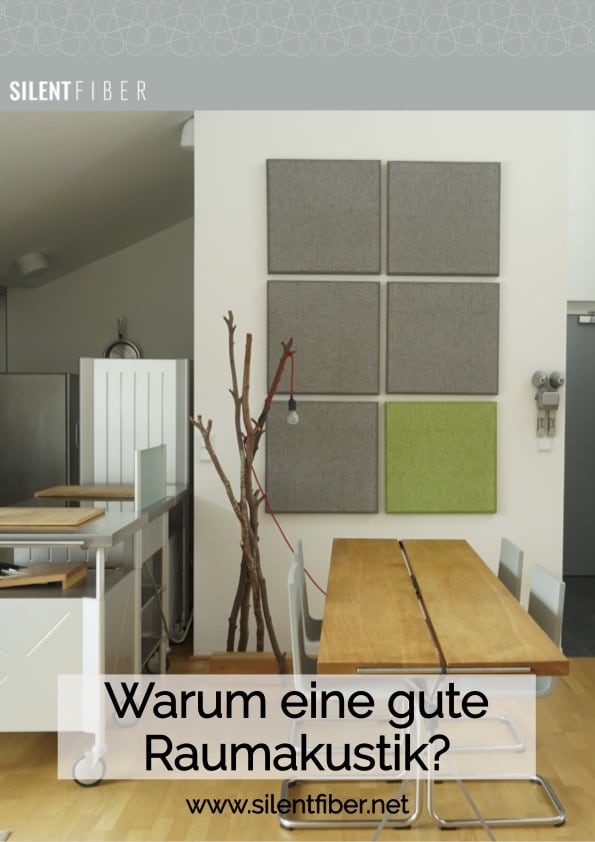With sound insulation for optimum room acoustics
An often neglected topic
At the Design of a room we all have a exact idea, what shape, color, furnishings, etc. we like. It falls to us here lee to formulate our claims and to judge whether and why we like an object or not.
This is quite different with the acoustic design of rooms. Room acoustics are often not taken into account when planning a room. However, a room can be as chic or hip as it is furnished - if it is our ear does not like it, we will not feel comfortable in it in the long run. But what do we perceive as acoustically pleasant? How can we positively change the room acoustics?
We have the most important information about room acoustics compiled for you here.
Reverberation time - the room acoustic business card of a room
The Reverberation time specifies the duration, how long you can hear the sound of a tone in the room resonates, although the Sound source already silenced is. The longer the reverberation time, the longer we hear the sound sound in the room - the room seems reverberant. With a too short reverberation time acts the Room dull. This measurable quantity makes rooms comparable. Also the Speech intelligibility stands in direct relationship with the reverberation of a room.
The reverberation time depends essentially depends on three factors:

A short reverberation time occurs, for example, in a smaller furnished room with carpeting and curtains. A longer reverberation time occurs in a larger unfurnished room with parquet flooring.
This table shows typical reverberation times of different types of rooms:


Absorption - the ability to "swallow" sound
We have now seen that a long reverberation time is the cause of reverberant sounding rooms and that the reverberation time can be reduced by absorption. But what is absorption now?
Sound absorption describes the Ability of materials to absorb sound and convert the incident sound energy into other forms of energy. Sound absorber, so acoustic panels, swallow so a Part of the sound energy.
In the case of sound absorption, the Sound absorption coefficient (α) a important key figure. It describes the property of a material not to reflect the incident sound, but to absorb it. Sound absorbers that 100 % of the incident sound swallow, have a Sound absorption coefficient of 1.0 (case 1). A completely reflecting surface, on the other hand, has a sound absorption coefficient of 0 (case 2). Both extremes are almost unattainable. Reality moves in between (case 3). Our SilentFiber Acoustic Panels have a sound absorption value of 0.75. The sound absorption coefficient is thus comparable with conventional sound absorbers made of foam or artificial mineral fibers.




How do SilentFiber acoustic panels provide sound insulation in the room?
Natural fibers, unlike glass, plaster or tile, are soft materials. The Sound refracts in the cavities of the natural fiber boards. More precisely a large part of the sound energy is converted into heatAs a result, less sound is reflected back - there is less echo. This increases the speech intelligibility in the room - the room appears quieter.
Do sound absorbers actually make the room quieter?
This question can be answered by two effects:
- Physical effect:
On the one hand, the Sound in a room actually damped by the sound absorption in the room, i.e., part of the sound energy is absorbed by the acoustic panels. By reducing the reverberation time, the sound level is lowered.
- Behavioral psychological effect:
Due to more favorable speaking and listening conditions for short reverberation values people lower their vote. (Conversely, when speech intelligibility is poor, we tend to raise our voice). That is, lowering the level by changing the behavior of users has an additional effect on lowering the sound level.

You can close your eyes - but not your ears!
The remarkable thing: Already in the Ancient the attention of the architects was not exclusively focused on the appearance of the buildings, but it was always considered that Rooms are also listening environments, which were already optimally adapted to their use at that time.
In modern buildings, one often experiences this differently: Large glass surfaces, surfaces of concrete or plaster and steel follow current trends and impress with purist aesthetics and clear lines. But all too often, living spaces, hallways, foyers and offices prove to be less than fit for purpose when users move in. A Volume reminiscent of a large construction siteYou understand every word from the opposite corner, only you can't follow your counterpart.
At the first step outside, you notice how your ears breathe a sigh of relief. Priorities are often set that are pleasing to the eyes but not to the ears.

Sound insulation vs. room acoustics
So that we are also talking about the same thing! Room acoustics are often confused with sound insulation. We explain the difference.


